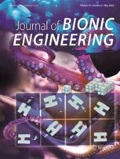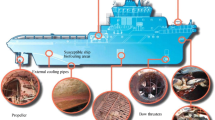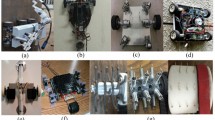Abstract
There are many design parameters to determine a performance of a robot. Especially, in the case of the mobile robots, they require complicated motion at various environments to get high performances. In this sense, the analysis of the design parameters is the most important work to design an efficient mobile robot. In this study, we analyze the design parameters for the water-running robot. From the parametric study, we find some solutions to improve the performances of the robot. We derive dynamic equations for the water-running motion, and do a sensitivity analysis to understand the relationships between the parameters (frequency of the leg, stiffness of torsional springs that connects multi frames and mass of frames) and the performance of the water-running motion such as running speed and pitching stability. We use an orthogonal array to make various combinations of the parameters, and to reduce the number of a simulation process. As results, we summarize some solutions to improve the water-running motion. We are expecting that this study is going to be used to design robots that are operated on the water.
Similar content being viewed by others
References
Jin S, Kim J, Kim J, Seo T. Six-degree-of-freedom hovering control of an underwater robotic platform with four tilting thrusters via selective switching control. IEEE/ASME Transaction on Mechatronics, 2015, 20, 2370–2378.
Kopman V, Cavaliere N, Porfiri M. MASUV-1: A miniature underwater vehicle with multidirectional thrust vectoring for safe animal interactions. IEEE/ASME Transaction on Mechatronics, 2012, 17, 563–571.
Liu J D, Hu H S. Biological inspiration: From carangiform fish to multi-joint robotic fish. Journal of Bionic Engineering, 2010, 7, 35–48.
Daou H E, Salumae T, Ristolainen A, Toming G, Listak M, Kruusmaa M. A bio-mimetic design and control of a fish-like robot using compliant structures. International Conference on Advanced Robotics, Tallinn, Estonia, 2011, 563–568.
Epps B P, Alvarado P V, Youcef-Toumi K, Techet A H. Swimming performance of a biomimetic compliant fish-like robot. Experiments in Fluids, 2009, 47, 927–939.
Kelasidi E, Liljeback P, Pettersen K Y, Gravdahl J T. Innovation in underwater robots: Biologically inspired swimming snake robots. IEEE Robotics & Automation Magazine, 2016, 23, 44–62.
Kelasidi E, Pettersen K Y, Gravdahl J T, Liljeback P. Modeling of underwater snake robots. IEEE International Conference on Robotics & Automation, Hong Kong, China, 2014, 4540–4547.
Song Y S, Sitti M. Surface-tension-driven biologically inspired water strider robots: Theory and experiments. IEEE Transactions on Robotics, 2007, 23, 578–589.
Ozcan O, Wang H, Taylor J D, Sitti M. Surface tension driven water strider robot using circular footpads. IEEE International Conference on Robotics and Automation, Anchorage, Alaska, USA, 2010, 3799–3804.
Glasheen J W, McMahon T A. A hydrodynamic model of locomotion in the basilisk lizard. Nature, 1996, 380, 340–342.
Glasheen J W, McMahon T A. Vertical water entry of disks at low Froude numbers. American Institute of Physics: Fluid, 1996, 8, 2078–2083.
Glasheen J W, McMahon T A. Size-dependence of waterrunning ability in basilisk lizards (Basiliscus basiliscus). The Journal of Experimental Biology, 1996, 199, 2611–2618.
Tonia H S. Three-dimensional hindlimb kinematics of water running in the plumed basilisk lizard. The Journal of Experimental Biology, 2003, 206, 4363–4377.
Tonia H S, Lauder G V. Running on water: Threedimensional force generation by basilisk lizards. PNAS, 2004, 101, 16784–16788.
Floyd S, Sitti M. Design and development of the lifting and propulsion mechanism for a biologically inspired water runner robot. Transactions on Robotics, 2008, 24, 698–709.
Park H S, Sitti M. Compliant footpad design analysis for a bio-inspired quadruped amphibious robot. IEEE/RSJ International Conference on Intelligent Robots and Systems, St. Louis, USA, 2009, 645–651.
Floyd S, Adilak S, Ramirez S, Rogman R, Sitti M. Performance of different foot designs for a water running robot. IEEE International Conference on Robotics and Automation, Panadena, CA, USA, 2008, 244–250.
Park H S, Floyd S, Sitti M. Roll and pitch motion analysis of a biologically inspired quadruped water runner robot. The International Journal of Robotics Research, 2010, 29, 1281–1297.
Xu L S, Mei T, Wei X M, Cao K, Luo M Z. A bio-inspired biped water running robot incorporating the Watt-I planar linkage mechanism. Journal of Bionic Engineering, 2013, 10, 415–422.
Xu L S, Wei X M, Cao K, Shi Y G. Dynamic analysis of fluid-structure interaction for the biped robot running on water. 12th International Conference on Control, Automation, Robotics & Vision, Guangzhou, China, 2012, 1546–1550.
Kim H, Lee D, Jeong K, Seo T. Water and ground-running robotic platform by repeated motion of six spherical footpads. IEEE/ASME Transaction on Mechatronics, 2016, 21, 175–183.
Kim H, Jeong K, Sitti M, Seo T. Tail-assisted mobility and stability enhancement in yaw/pitch motions of a waterrunning robot. IEEE/ASME Transaction on Mechatronics, 2017, 22, 1207–1217.
Kim H, Liu Y, Jeong K, Seo T. Empirical study on shapes of the foot pad and walking gaits for water-running robots. Journal of Bionic Engineering, 2014, 11, 572–580.
Klann J C. Walking Device. U. S. Patent 6478314, 2002.
Kim H, Jeong K, Seo T. Analysis and experiment on the steering control of a water-running robot using hydrodynamic forces. Journal of Bionic Engineering, 2017, 14, 34–46.
Roy R K. A Primer on the Taguchi Method, 2nd ed, Van Nostrand Reinhold, New York, USA, 1990.
Acknowledgment
This work was supported by the research fund of Hanyang University (HY-2018).
Author information
Authors and Affiliations
Corresponding author
Rights and permissions
About this article
Cite this article
Kim, H., Liu, Y. & Seo, T. Parametric Study on Design Parameters of Water-running Robot Based on Dynamic Simulation. J Bionic Eng 15, 960–970 (2018). https://doi.org/10.1007/s42235-018-0084-y
Published:
Issue Date:
DOI: https://doi.org/10.1007/s42235-018-0084-y




